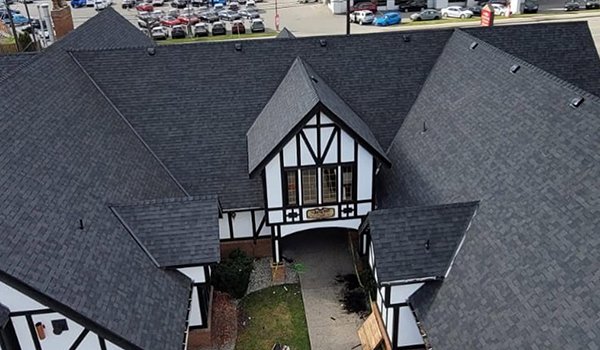
The commercial roofing sector is accelerating toward a 2025 characterized by innovation, sustainability, and durability. Today’s facility owners and property managers are prioritizing extended product lifecycles, integrated smart systems, and eco-conscious configurations to optimize lifetime value. Whether you are vetting a new roofing system, evaluating a replacement cycle, or planning maintenance interventions, familiarity with the following trends will enhance both strategic and financial outcomes.
Drawing from years of service in the Vancouver market, our contracting firm has identified the trends that will shape the commercial roofing landscape through the end of the decade.
1. Improved Durability and Weather Resilience
The Rationale Behind Increasing Durability
The intensification of weather phenomena—intense rainfall, elevated wind speeds, and hail—renders conventional roofing systems insufficient. In response, the market is gravitating toward impact-rated shingles, advanced, puncture-resistant membranes, and engineered underlayment layers that boost structural integrity.
For Vancouver, where saturated winters and periodic gale-force winds create challenging seasons, the case for rigorous durability becomes operationally critical. Selecting higher-grade materials at the outset of a project establishes a protective margin that minimizes the frequency and financial impact of unplanned repair events.
2. The Expanding Adoption of Metal Roof Systems
Reasons Firms Are Transitioning to Metal
Metal roof systems rank among the swiftest-growing options for commercial coverings, delivering service lives often ranging from 40 to 70 years, superior fire resistance, and sharply reduced maintenance intervals. Their high solar reflectivity diminishes heat absorption during summer months, translating to lower cooling loads and, consequently, to reduced electricity expenditures.
Owners contemplating roof replacement schedules for 2025 will find metal assemblies to be a resilient, cost-effective investment that aligns with sustainable building practices. The industry is increasingly combining such systems with photovoltaic technology, thereby amplifying the return on energy performance investments.
3. Low-Energy Strategies: Reflective Roofs and BIPV
Reflective Roof Assemblies
Cool roof technologies incorporate membranes, coatings, or tiles engineered to reflect a significant fraction of incident solar radiation. The ensuing interior temperature stability lessens the cooling load on the mechanical envelope, delivering lower energy bills and extending service lives for both the roof and the HVAC infrastructure.
Building-Integrated Photovoltaics
Concurrently, the integration of solar panels directly into the roof surface is becoming standard, capitalizing on large commercial footprints to colocalize electricity production with the building envelope. The resultant onsite energy offsets overhead from purchased power and contributes positively to the enterprise’s sustainability reporting.
Incorporating both reflective and photovoltaic-ready designs during either installation or replacement phases will yield multi-decade performance vertically aligned with reduced operational expenditure and lower carbon intensity.
4. Responsive Roofing Systems and Continuous Condition Monitoring
The Emergence of Intelligent Roofing
The roofing sector is undergoing a technological upgrade. Contemporary roofing assemblies are now equipped with distributed sensor networks that continuously measure thermal profile, humidity gradients, and deformation strain. This continuous flow of telemetry enables facility managers to diagnose latent failures—such as hidden infiltrations or thermal bridging—prior to their manifestation as costly repair events.
UAV-Enhanced Roofing Surveys
Complementing inbuilt sensors, unmanned aerial vehicles are progressively incorporated as inspection instruments. Leveraging multispectral and thermographic imaging, these drones can traverse extensive commercial rooftops in a fraction of the time required for conventional footborne surveys, delineating both previously undetectable deterioration and surface anomalies without elevating occupational safety risks.
5. Circular and Bioclimatic Roofing Assemblies
The Imperative for Low-Impact Construction
By 2025, the commercial sector is expected to rectify the extrusion of linear resource consumption by favouring materials that can enter a closed loop. This includes pre- and post-consumer recyclables, fast-growing biopolymers, and substrates produced with minimal embodied energy. Biophilic roofing environments, comprising engineered soil, vegetation modules, and drainage composites, are becoming mainstream for their sequestration of airborne particulates, attenuation of runoff, and incremental thermal buffering.
In the Vancouver metropolitan region, these living roofs additionally furnish compliance to the City’s green building bylaws, thus serving as a prudent Specification for both initial deployments and reroofing programmes.
6. Advanced Roofing Coatings
Modern roof coatings are formulated to provide exceptional waterproofing, ultraviolet light shielding, and microbial resistance. When properly applied, they can appreciably lengthen the service life of an existing roof assembly and decrease the need for premature replacement.
In climates characterized by heavy and persistent rain, such as the Vancouver region, the application of a durable reflective membrane is frequently incorporated into a proactive roof management plan. By doing so, a facility owner can defer significant repair expenditures while simultaneously safeguarding the capital previously allocated to the roof system.
7. Modular Prefabricated Roofing Systems
Off-site prefabricated roof panels and related components are fabricated to stringent tolerances and are then transported for rapid assembly. This methodology minimizes on-site labor, curtails the duration of exposure to harsh weather, and enhances overall dimensional accuracy.
For building stakeholders, the modular approach translates into shorter construction timelines, diminished disruption to ongoing operations, and the potential for reduced labor and material costs.
8. Preventive Maintenance Programs
Preventive roof care is gaining broad acceptance as a standard practice for institutional and commercial assets. By enrolling in scheduled inspection and service contracts with certified Vancouver roofing contractors, property managers can detect and rectify minor defects before they escalate.
This disciplined, forward-looking regimen not only averts the expense and inconvenience of emergency repairs, it also maximizes the performance and value recovery from the roof system over its entire service life.
10. Re-Roofing Demand and Market Growth
The steady maturation of commercial roofing inventories means that many systems will reach the end of their predictable service life by 2025. Compounding demographic and fiscal pressures—from aging physical assets to revised energy and resiliency codes—encourage building owners to select roofing assemblies that deliver better thermal performance, extended life cycles, and a smaller embodied carbon footprint. Firms that allocate replacement funding in the current budget cycle can avoid costly service interruptions, latent moisture damage, and the higher price premiums associated with last-minute emergency procurement.
11. Why Choose a Roofing Contractor in Vancouver Who Understands These Trends
Integrating the latest roofing innovations into a commercial project requires a fusion of technical calibration, field experience, and awareness of regional climatic and regulatory pressures. An established Vancouver roofing contractor possesses the technical acumen to prescribe the optimal membrane, insulation, and accessory systems that comply with the City’s seismic performance criteria and microclimatic rain records. Whether the assignment is a full roof replacement, a re-roof of a legacy structure, or a service repair, collaboration with a specialized contractor ensures the longevity of the asset and the financial integrity of the project.
Final Thoughts
The commercial roofing sector in 2025 is underscored by advanced material science, systems resiliency, and life-cycle sustainability. Innovations such as impact-resistant thermoplastics, integrated building sensors, and highly reflective, low-HGL assemblies create new paradigms for performance and operational economy. These options empower owners to safeguard and enhance the value of their properties while meeting the accelerating expectations of clients, tenants, and regulatory agencies.
For those seeking a roofing contractor in Vancouver with a proven grasp of contemporary roofing technology and market trends, our dedicated team stands ready to assist. We focus on complete roof installation, selective roof replacement, and precision roof repair, guaranteeing that each commission adheres to peak benchmarks for structural integrity, thermal efficiency, and lifecycle value.
Reach out to Humble Roofing for a no-obligation consultation and learn how we can engineer a commercial roofing system that remains resilient and cost-effective for the long term.

